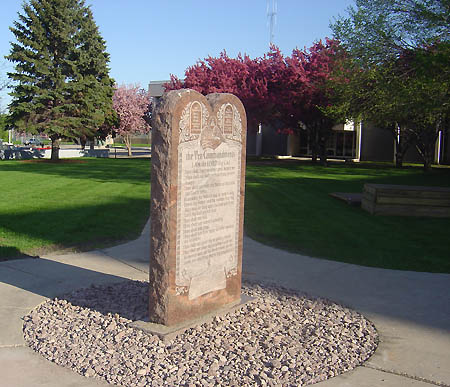Ten Commandments
County: Cass, North Dakota
Location: city property, in plaza S of Fargo Civic Center

Coordinates: N46o52.676' W96o46.053'
On March 8, 1958, at the height of the Cold War at home and abroad, Fargo Mayor Herschel Lashkowitz gladly accepted a gift from the Fraternal Order of Eagles of a Ten Commandments monument. The monument was one of thousands distributed by the Eagles throughout the country, and its placement on city property did not seem to inspire significant public controversy.
In the meantime, the Supreme Court has drawn a sharp (if not entirely clear) First Amendment line between freedom of religious expression and prohibition of state establishment of religion. In other words, the courts have ruled that religious symbolism in governmental contexts, including courthouses, could in some cases lead to the identification of the state with a particular religion. At the same time, however, courts have ruled that religious markers of various sorts on public property could have valid historical, cultural, or other secular purposes.
The Red River Freethinkers filed suit against the city of Fargo in 2003, claiming the monument violated the First Amendment establishment clause. However, city officials argue that the site is a historical monument, a symbol of American values and a commemoration of the Cold War. Some maintain as well that the Ten Commandments are the underlying source of American law, although others counter that its roots in Roman and Greek jurisprudence should be equally acknowledged. In accordance with a recent Supreme Court ruling in a very similar case (Van Orden v. Perry), the Federal District Court in Fargo ruled in the city's favor. Yet the debate continues with little sign of resolution. Perhaps it was the idea of the founders of the Constitution that issues as complex as this one should never be put to rest, that we must continue to debate them in order to remind us that we are free not only to express our individual opinions, but to assert our personal
principles as well.--Research by William Harris, HIST 489, NDSU, Spring 2007
Recommended Reading
Krythe, Maymie. What So Proudly We Hail. New York: Harper & Row, 1968.
Levy, Leonard. The Establishment Clause: Religion and the First Amendment. Chapel Hill: University of North Carolina Press, 1994.
Ojeda, Auriana. Civil Liberties. Farmington Hills, Michigan: Greenhaven Press, 2004.
Van Orden v. Perry
Wesley Twombly, et al. v. City of Fargo
| Photo Gallery |
 |
 |
 |
 |
Photos by Bill Harris, 9 May 2007 |
Video
1 August 2007 |
|---|
Want to talk about this monument, or other heritage sites on the northern plains? Join the discussion on Facebook. Check out the center's Facebook group, Heritage Trails.
 Remembrance in Stone / Center for Heritage Renewal
Remembrance in Stone / Center for Heritage Renewal
|